Benelux
The Benelux Union (Dutch: Benelux Unie;[4] French: Union Benelux;[5] Luxembourgish: Benelux-Unioun),[6] also known as simply Benelux, is a politico-economic union and formal international intergovernmental cooperation of three neighbouring states in western Europe: Belgium, the Netherlands, and Luxembourg.[7] The name Benelux is a portmanteau formed from joining the first few letters of each country's name – Belgium, Netherlands, Luxembourg – and was first used to name the customs agreement that initiated the union (signed in 1944).[8] It is now used more generally to refer to the geographic, economic, and cultural grouping of the three countries.
Benelux Union | |
|---|---|
Logo
| |
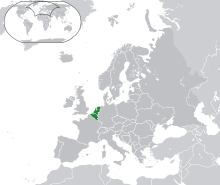 | |
Member states of the Benelux Union
| |
| Administrative centre and largest agglomeration | Brussels 50°51′N 4°21′E |
| Official languages | Dutch and French[1] |
| Other official languages | German, Luxembourgish, West Frisian, Low Saxon, Limburgish |
| Type | Politico‑economic union |
| Member states | |
| Legislature | Parliament |
| Establishment | |
• Customs union treaty signed | 5 September 1944[2] |
• Customs union in effect | 1 January 1948[2] |
• Renewal signed | 17 June 2008 |
• Renewal in effect | 1 January 2010 |
| Area | |
• Total | 75,149 km2 (29,015 sq mi) |
| Population | |
• 1 November 2019 estimate | 29,554,771 |
• Density | 394/km2 (1,020.5/sq mi) |
| GDP (PPP) | 2018 estimate |
• Total | $1.580 trillion[3] |
• Per capita | $48,359 |
| Currency | Euro (EUR) |
| Time zone | UTC+1 (CET) |
| UTC+2 (CEST) | |
| Driving side | right |
Website www | |
Cooperation among the governments of Belgium, the Netherlands, and the Grand Duchy of Luxembourg has been a firmly established practice since the introduction of a customs union in 1944 which became operative in 1948 as the Benelux Customs Union. The initial form of economic cooperation expanded steadily over time, leading in 1958 to the signing of the treaty establishing the Benelux Economic Union. Initially, the purpose of cooperation among the three partners was to put an end to customs barriers at their borders and ensure free movement of persons, goods and services among the three countries. It was the first example of international economic integration in Europe since the Second World War. The three countries therefore foreshadowed and provided the model for future European integration, such as the European Coal and Steel Community, the European Economic Community (EEC), and the European Community/European Union (EC/EU). The three partners continue to play this pioneering role. They also launched the Schengen process, which came into operation in 1985, promoting it from the outset. Benelux cooperation has been constantly adapted and now goes much further than mere economic cooperation, extending to new and topical policy areas connected with security, sustainable development, and the economy. Benelux models its cooperation on that of the European Union and is able to take up and pursue original ideas. The Benelux countries also work together in the so-called Pentalateral Energy Forum, a regional cooperation group formed of five members - the Benelux states, France, Germany, Austria, and Switzerland. Formed ten years ago, the ministers for energy from the various countries represent a total of 200 million residents and 40% of the European electricity network. As of November 2019, the Benelux Union has a population of more than 29.55 million.
On 17 June 2008, Belgium (in all its component parts), the Netherlands, and Luxembourg signed a new Benelux treaty in The Hague. The purpose of the Benelux Union is to deepen and expand cooperation among the three countries so that it can continue its role as precursor within the European Union and strengthen and improve cross-border cooperation at every level. Through better cooperation between the countries the Benelux strives to promote the prosperity and welfare of the citizens of Belgium, the Netherlands and Luxembourg.
Benelux works together on the basis of an annual plan embedded in a four-year joint work programme.[9]
Benelux seeks region-to-region cooperation, be it with France and Germany (North Rhine-Westphalia) or beyond with the Baltic States, the Nordic Council, the Visegrad countries, or even further. In 2018 a renewed political declaration was adopted between Benelux and North Rhine-Westphalia to give cooperation a further impetus.
Some examples of recent results of Benelux cooperation: automatic level recognition of all diplomas and degrees within the Benelux, a new Benelux Treaty on Police cooperation, common road inspections and a Benelux pilot with digital consignment notes. The Benelux is also committed to working together on adaptation to climate change. On 5 June 2018 the Benelux (Treaty) celebrated its 60 years of existence.[10] In 2018, a Benelux Youth Parliament was created.
The main institutions of the Union are the Committee of Ministers, the Council of the Union, the General Secretariat, the InterParliamentary Consultative Council and the Benelux Court of Justice while the Benelux Office for Intellectual Property cover the same territory but are not part of the Benelux Union.
The Benelux General Secretariat is located in Brussels. It is the central platform of the Benelux Union cooperation. It handles the secretariat of the Committee of Ministers, the Council of Benelux Union and the various committees and working parties. The General Secretariat provides day-to-day support for the Benelux cooperation on the substantive, procedural, diplomatic and logistical levels. The Secretary-General is Alain de Muyser. The Deputy Secretary-General NL is Frank Weekers and the Deputy Secretary-General BE is Rudolf Huygelen.
The presidency of the Benelux is held in turn by the three countries for a period of one year. The Netherlands hold the presidency in 2020.
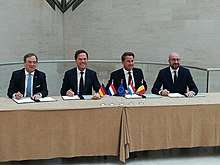
In addition to cooperation based on a Treaty, there is also political cooperation in the Benelux context, including summits of the Benelux government leaders. In 2019 a Benelux summit was held in Luxembourg.[11]
Politics
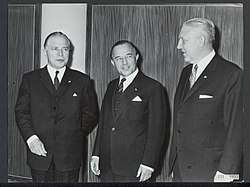
_en_Wilfried_Martens_(Belgi%C3%AB%2C_Bestanddeelnr_932-3952.jpg)
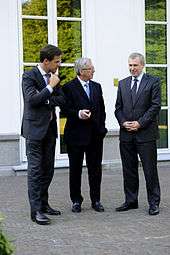
A Benelux Parliament (originally referred to as an "Interparliamentary Consultative Council") was created in 1955. This parliamentary assembly is composed of 21 members of the Dutch parliament, 21 members of the Belgian national and regional parliaments, and 7 members of the Luxembourg parliament. On 20 January 2015, the governments of the three countries, including, as far as Belgium is concerned, the community and regional governments, signed in Brussels the Treaty of the Benelux Interparliamentary Assembly . This treaty will enter into force on the 1st of August 2019. This means the 1955 Convention on the Consultative Interparliamentary Council for the Benelux expires. Moreover, the current official name has been largely obsolete in daily practice for a number of years now. Both internally in the Benelux and in external references, the name Benelux Parliament has been used de facto for a number of years now.
In 1944, exiled representatives of the three countries signed the London Customs Convention, the treaty that established the Benelux Customs Union. Ratified in 1947, the treaty was in force from 1948 until it was superseded by the Benelux Economic Union. The treaty establishing the Benelux Economic Union (Benelux Economische Unie/Union Économique Benelux) was signed on 3 February 1958 in The Hague and came into force on 1 November 1960 to promote the free movement of workers, capital, services, and goods in the region. Under the Treaty the Union implies the co-operation of economic, financial and social policies.
Cooperation with other Geopolitic-regions
In 2017 the members of the Benelux, the Baltic Assembly, and three members of the Nordic Council (Sweden, Denmark and Finland), all EU-member states, sought intensifying cooperation in the Digital Single Market, as well as discussing social matters, the Economic and Monetary Union of the European Union, the European migrant crisis and defence cooperation. Relations with Russia, Turkey and the United Kingdom was also on the agenda.[12]
Since 2008 the Benelux Union works together with the German Land (state) North Rhine-Westphalia.
In 2018 Benelux Union signed a declaration with France to strengthen cross-border cooperation.
Benelux legal instruments

The Benelux Union involves an intergovernmental cooperation.[13]
The Treaty establishing the Benelux Union explicitly provides that the Benelux Committee of Ministers can resort to four legal instruments (art. 6, paragraph 2, under a), f), g) and h)):[14]
1. Decisions
Decisions are legally binding regulations for implementing the Treaty establishing the Benelux Union or other Benelux treaties.
Their legally binding force concerns the Benelux states (and their sub-state entities), which have to implement them. However, they have no direct effect towards individual citizens or companies (notwithstanding any indirect protection of their rights based on such decisions as a source of international law). Only national provisions implementing a decision can directly create rights and obligations for citizens or companies.
2. Agreements
The Committee of Ministers can draw up agreements, which are then submitted to the Benelux states (and/or their sub-state entities) for signature and subsequent parliamentary ratification. These agreements can deal with any subject matter, also in policy areas that are not yet covered by cooperation in the framework of the Benelux Union.
These are in fact traditional treaties, with the same direct legally binding force towards both authorities and citizens or companies. The negotiations do however take place in the established context of the Benelux working groups and institutions, rather than on an ad hoc basis.
3. Recommendations
Recommendations are non-binding orientations, adopted at ministerial level, which underpin the functioning of the Benelux Union. These (policy) orientations may not be legally binding, but given their adoption at the highest political level and their legal basis vested directly in the Treaty, they do entail a strong moral obligation for any authority concerned in the Benelux countries.
4. Directives
Directives of the Committee of Ministers are mere inter-institutional instructions towards the Benelux Council and/or the Secretariat-General, for which they are binding. This instrument has so far only been used occasionally, basically in order to organise certain activities within a Benelux working group or to give them impetus.
All four instruments require the unanimous approval of the members of the Committee of Ministers (and, in the case of agreements, subsequent signature and ratification at national level).
In 1965, the treaty establishing a Benelux Court of Justice was signed. It entered into force in 1974.[15] The Court, composed of judges from the highest courts of the three States, has to guarantee the uniform interpretation of common legal rules. This international judicial institution is located in Luxembourg.
The Benelux is particularly active in the field of intellectual property. The three countries established a Benelux Trademarks Office and a Benelux Designs Office, both situated in The Hague. In 2005, they concluded a treaty establishing a Benelux Organisation for Intellectual Property which replaced both offices upon its entry into force on 1 September 2006. This Organisation is the official body for the registration of trademarks and designs in the Benelux. In addition, it offers the possibility to formally record the existence of ideas, concepts, designs, prototypes and the like.[16]
All higher education degrees recognised throughout Benelux
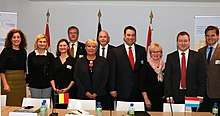
In 2018 Education ministers from all three of Belgium's regions as well as from the Netherlands and Luxembourg have signed an agreement[17] to recognise the level of all higher education diplomas between the three countries. This is unique in the EU. To continue studies or get a job in another country, applicants must get their locally earned degree recognised by the other country, which entails a lot of paperwork, fees and sometimes a months-long wait. In 2015, the Benelux countries agreed to automatically recognise each other's bachelor's and master's diplomas. Now that recognition is extended to PhDs and to so-called graduate degrees, which are earned from adult educational institutions. This means that a graduate of any of the three countries can continue their education or seek a job in the other countries without having to get their degree officially recognised.
New Benelux Treaty on police cooperation
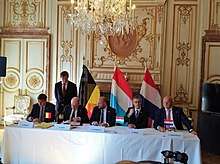
The Belgian Minister of Security and Home Affairs, Jan Jambon, the Belgian Minister of Justice, Koen Geens, the Dutch Minister of Justice and Security, Ferdinand Grapperhaus, the Luxembourg Minister of Homeland Security, Etienne Schneider and the Luxembourg Minister of Justice, Félix Braz, signed in 2018 a new Benelux police treaty,[18] which will improve the exchange of information, create more opportunities for cross-border action and facilitate police investigations in the neighbouring country. In 2004, a Treaty on cross-border cooperation between the Benelux police forces was concluded. This has been completely revised and expanded. The Benelux countries are at the forefront of the European Union in this respect.
This new Treaty will allow direct access to each other's police databases on the basis of hit/no hit. In addition, direct consultation of police databases will be possible during joint operations and in common police stations. It will also be possible to consult population registers within the limits of national legislation. In the future, ANPR (Automatic Number Plate Recognition) camera data, which play an increasingly important role in the fight against crime, can be exchanged between the Benelux countries in accordance with their own applicable law. Police and judicial authorities will also work more closely with local authorities to exchange information on organised crime in a more targeted way (administrative approach) in accordance with national law.
The Treaty makes cross-border pursuit a lot easier and broadens the investigative powers of Benelux police officers. For example, it will be possible to continue a lawful hot pursuit in one's own country across the border, without the thresholds for criminal offences that characterise the current regulation. Another new feature of the Treaty is that a police officer can, under certain conditions, carry out cross-border investigations.
The existing intensive cooperation in the field of police liaison officers, joint patrols and checks as well as the provision of assistance at major events will be maintained. In addition, the possibilities for cross-border escort and surveillance missions and for operating on international trains will be considerably extended.
In the event of a crisis situation, special police units will now be able to act across borders; this can also be used to support important events with a high security risk, such as a NATO Summit.
After approval by the parliaments, and the elaboration of implementation agreements, the new Benelux Police Treaty will enter into force.
Benelux Treaty of Liège: joint Benelux road transport inspections

The Treaty of Liège entered into force in 2017.[19] As a result, Dutch, Belgian and Luxembourg inspectors may carry out joint inspections of trucks and buses in the three countries. This treaty was signed in 2014 in Liège (Belgium) by the three countries. In the meantime, on the basis of a transitional regime and pending the entry into force of the Treaty, several major Benelux road transport inspections have taken place. Under this transition regime, inspectors from neighbouring countries could only act as observers. Now they can exercise all of their skills.
Co-operation on the basis of this Benelux Treaty leads to a more uniform control of road transport, cost reductions, more honest competition between transport companies and better working conditions for drivers. In addition, this cooperation strengthens general road safety in the three countries.
The Benelux Treaty seeks to intensify cooperation by improving the existing situation through intensive harmonisation of controls, exchange of equipment and training of personnel in order to reduce costs and by allowing inspectors of a country to participate in Inspections in another Benelux country by exercising all their powers, which in particular enables the expertise of the specialists in each country to be obtained. In so doing, they are fully committed to road safety for citizens and create a level playing field, so that entrepreneurs inside and outside the Benelux must comply with the same rules of control.
The application of the Treaty of Liège allows the three Benelux countries to play the role of forerunners in Europe. In addition, the treaty expressly provides for the possibility of accession of other countries.
By June 2019 already a total of 922 vehicles were subject to common Benelux inspections.
Characteristics
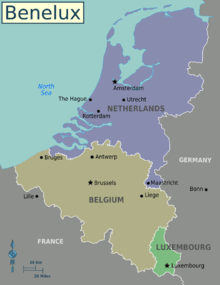
Countries
Associated territories
Renewal of the agreement
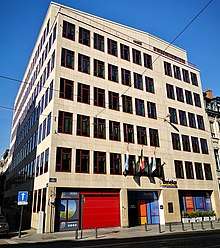
The Treaty between the Benelux countries establishing the Benelux Economic Union was limited to a period of 50 years. During the following years, and even more so after the creation of the European Union, the Benelux cooperation focused on developing other fields of activity within a constantly changing international context.
At the end of the 50 years, the governments of the three Benelux countries decided to renew the agreement, taking into account the new aspects of the Benelux-cooperation – such as security – and the new federal government structure of Belgium. The original establishing treaty, set to expire in 2010, was replaced by a new legal framework (called the Treaty revising the Treaty establishing the Benelux Economic Union), which was signed on 17 June 2008.
The new treaty has no set time limit and the name of the Benelux Economic Union changed to Benelux Union to reflect the broad scope on the union.[59] The main objectives of the treaty are the continuation and enlargement of the cooperation between the three member states within a larger European context. The renewed treaty explicitly foresees the possibility that the Benelux countries will cooperate with other European member States or with regional cooperation structures. The new Benelux cooperation focuses on three main topics: internal market and economic union, sustainability, justice and internal affairs. The number of structures in the renewed Treaty has been reduced and thus simplified. Five Benelux institutions remain: the Benelux Committee of Ministers, the Benelux Council, the Benelux Parliament, the Benelux Court of Justice, the Benelux Secretariat General. Beside these five institutions, the Benelux Organisation for Intellectual Property is also present in this Treaty as an independent organisation.
Benelux Committee of Ministers:
The Committee of Ministers is the supreme decision-making body of the Benelux. It includes at least one representative at ministerial level from the three countries. Its composition varies according to its agenda. The ministers determine the orientations and priorities of Benelux cooperation. The presidency of the Committee rotates between the three countries on an annual basis.
Benelux Council:
The Council is composed of senior officials from the relevant ministries. Its composition varies according to its agenda. The Council's main task is to prepare the dossiers for the ministers.
Benelux InterParliamentary Consultative Council:
The Benelux Parliament comprises 49 representatives from the parliaments of Belgium, the Netherlands and Luxembourg. Its members inform and advise their respective governments on all Benelux matters.
Benelux Court of Justice:
The Benelux Court of Justice is an international court. Its mission is to promote uniformity in the application of Benelux legislation. When faced with difficulty interpreting a common Benelux legal rule, national courts must seek an interpretive ruling from the Benelux Court, which subsequently renders a binding decision. The members of the Court are appointed from among the judges of the 'Cour de cassation' of Belgium, the 'Hoge Raad of the Netherlands' and the 'Cour de cassation' of Luxembourg.
Benelux General Secretariat:
The General Secretariat, which is based in Brussels, forms the cooperation platform of the Benelux Union. It acts as the secretariat of the Committee of Ministers, the Council and various commissions and working groups. Because the General Secretariat operates under strict neutrality, it is perfectly placed to build bridges between the various partners and stakeholders. The General Secretariat has years of expertise in the area of Benelux cooperation and is familiar with the policy agreements and differences between the three countries. Building on what already been achieved, the General Secretariat puts its knowledge, network and experience at the service of partners and stakeholders who endorse its mission. It initiates, supports and monitors cooperation results in the areas of economy, sustainability and security. In a greatly enlarged European Union, Benelux cooperation is a source of inspiration for Europe.
See also
Notes
- In the Caribbean parts of the Netherlands, namely Saba, Sint Eustatius and Bonaire.
References
- "Révision portant sur le traité de 1958" (PDF) (in French). 2008.
Article 38 : le français et le néerlandais sont les langues officielles des institutions de l'Union Benelux
- Peaslee, Amos Jenkins; Xydis, Dorothy Peaslee (1974). International governmental organizations. BRILL. p. 165. ISBN 978-90-247-1601-2. Retrieved 4 September 2011.
- International Monetary Fund Statistics
- "Over de Benelux" (in Dutch). Benelux. Retrieved 9 February 2015.
Dit alles onder een nieuwe naam: de Benelux Unie.
- "A propos du Benelux" (in French). Benelux. Retrieved 9 February 2015.
Le 17 juin 2008, un nouveau Traité Benelux était signé. Désormais, la coopération va se concentrer sur trois thèmes-clés: le marché intérieur & l’union économique, le développement durable et la justice & les affaires intérieures et tout ceci sous un nouveau nom:l’Union Benelux.
- "De Benelux" (in Luxembourgish). Government of Luxembourg. Retrieved 21 October 2018.
D’Benelux-Unioun besteet aus dem Kinnekräich Belsch, dem hollännesche Kinnekräich an dem Groussherzogtum Lëtzebuerg.
- "Benelux Treaty of Economic Union - Belgium-Luxembourg-Netherlands [1958]".
- Revue de l'Institut International de Statistique (1947) Vol. 15, No. 1/4, page 43. However, according to The Economist, it was coined in August 1946 by that newspaper's correspondent in Belgium ("Going Dutch". The Economist. 3 May 2008. Retrieved 6 September 2012.).
- http://www.benelux.int/files/8514/9933/4534/Common_Work_Programme_2017-2020.pdf
- "A 60th anniversary for the Benelux Union". 3 June 2018.
- http://www.benelux.int/files/9415/5427/7383/20190402_Decl_Benelux_Summit_EN_Final.pdf
- ERR (22 June 2017). "Ratas meets with Benelux, Nordic, Baltic leaders in the Hague".
- https://www.urm.lt/default/en/foreign-policy/lithuania-in-the-region-and-the-world/regional-cooperation/intergovernmental-cooperation-of-the-baltic-and-the-benelux-countries
- http://www.benelux.int/files/3914/0067/7093/trait_Benelux_17.06.2008Ondertekend.pdf
- "Algemene voorstelling van het Benelux-Gerechtshof". Benelux-Gerechtshof. Retrieved 10 May 2016.
- Archived 4 June 2015 at the Wayback Machine
- http://www.benelux.int/files/4815/1721/2154/M20181_FR_.docx.pdf
- http://www.benelux.int/files/6615/3258/9333/2018-07-23_Verdrag_Politie_NL-FR_signe.pdf
- http://www.benelux.int/files/5414/1457/2528/Trait_Benelux_inspection_du_transport_routier.pdf
- "Europe :: Belgium". CIA The World Factbook.
- "Europe :: Netherlands". CIA The World Factbook.
- "Europe :: Luxembourg". CIA The World Factbook.
- ""World Population prospects – Population division"". population.un.org. United Nations Department of Economic and Social Affairs, Population Division. Retrieved 9 November 2019.
- ""Overall total population" – World Population Prospects: The 2019 Revision" (xslx). population.un.org (custom data acquired via website). United Nations Department of Economic and Social Affairs, Population Division. Retrieved 9 November 2019.
- "Language selection - Statbel" (PDF). www.statbel.fgov.be.
- "Urbanaudit.org". Archived from the original on 9 January 2006.
- "Urbanaudit.org". Archived from the original on 9 January 2006.
- "Urbanaudit.org". Archived from the original on 9 January 2006.
- "Urbanaudit.org". Archived from the original on 9 January 2006.
- "Urbanaudit.org". Archived from the original on 9 January 2006.
- Statistics Netherlands.
- Wet op het gebruik van de Friese taal
- Invoeringswet openbare lichamen Bonaire, Sint Eustatius en Saba
- Eurobarometer 393: Discrimination in the EU in 2012 (PDF). European Commission. pp. 233–234. Retrieved 29 December 2015.
- Schmeets, Hans; Mensvoort, Carly van (2015). Religieuze betrokkenheid van bevolkingsgroepen, 2010–2014, Centraal Bureau voor de Statistiek
- "Discrimination in the EU in 2012 – Special Eurobarometer 393 (The question asked was "Do you consider yourself to be...?")" (PDF). European Commission. Retrieved 2 February 2016.
- "World Economic Outlook Database". International Monetary Fund. April 2016.
- "GDP (current US$)" (PDF). World Development Indicators. World Bank. Retrieved 2 July 2015.
- "GDP and its breakdown at current prices in US Dollars". United Nations Statistics Division. December 2015.
- "GDP (Official Exchange Rate)". The World Factbook. Central Intelligence Agency. Retrieved 4 June 2015.
- Some data refers to IMF staff estimates but some are actual figures for the year 2015, made in April 2016. World Economic Outlook Database-April 2016, International Monetary Fund. Accessed on 12 April 2016.
- Data refer mostly to the year 2014. selecting all countries, GDP per capita (current US$), World Bank. Accessed on 9 July 2015.
- National Accounts Main Aggregates Database, December 2014, (Select all countries, "GDP, Per Capita GDP - US Dollars", and 2014 to generate table), United Nations Statistics Division. Accessed on 4 Jan 2016.
- "Report for Selected Country Groups and Subjects (PPP valuation of country GDP)". IMF. Retrieved 13 June 2016.
- Data (2 July 2015). ""Gross domestic product 2014, PPP", World Bank, accessed on 2 July 2015" (PDF). Data.worldbank.org. Retrieved 2 July 2015.; European Union calculated by sum of individual countries.
- "The World Factbook—Central Intelligence Agency".
- World Economic Outlook Database, April 2016, International Monetary Fund. Database updated on 12 April 2016. Accessed on 14 April 2016.
- "GDP per capita, PPP (current international $)", World Development Indicators database, World Bank. Database updated on 11 April 2016. Accessed on 14 April 2016.
- GDP - per capita (PPP), The World Factbook, Central Intelligence Agency. Accessed on 7 March 2014.
- "The World Factbook—Central Intelligence Agency".
- http://www.imf.org/external/pubs/ft/weo/2016/01/pdf/text.pdf
- IISS 2014, pp. 77-79
- IISS 2014, pp. 121-123
- IISS 2014, p. 117
- "COUNTRY COMPARISON :: LABOR FORCE". cia.gov. Archived from the original on 30 May 2016. Retrieved 4 August 2014.
- "Central America and Caribbean :: Aruba". CIA The World Factbook.
- "Central America and Caribbean :: Curacao". CIA The World Factbook.
- "Central America and Caribbean :: Sint Maarten". CIA The World Factbook.
- Benelux union Archived 1 October 2009 at the Wayback Machine
Further reading
- Kersten, A.E. (1982). Maken drie kleinen een grote? De politieke invloed van de Benelux, 1945-1955. Bussum: Van Holkema & Warendorf. OCLC 63269615.
- Willy van Ryckeghem : Benelux in: The European Economy - Growth and Crisis, Andrea Boltho, Editor, Oxford University Press, 1982, ISBN 0-19-877118-5.
External links
| Wikimedia Commons has media related to Benelux. |
| Wikivoyage has a travel guide for Benelux. |
- Official sites
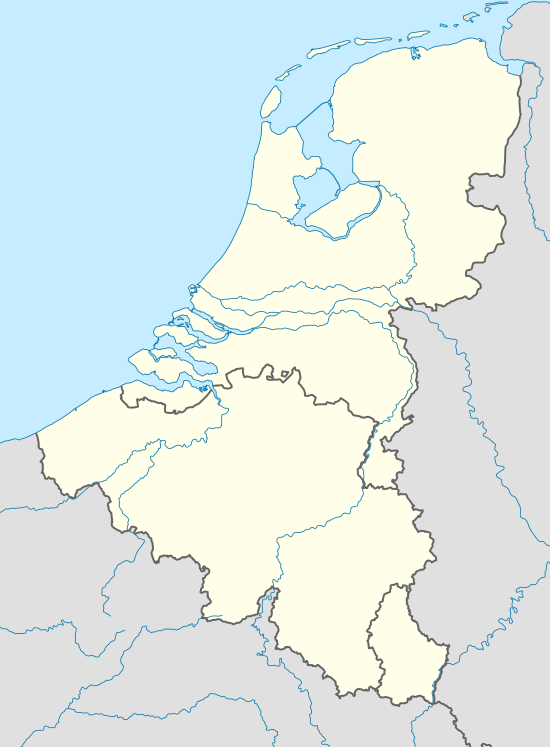

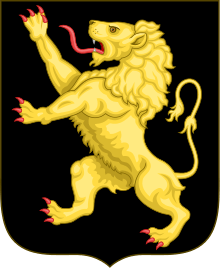




.svg.png)